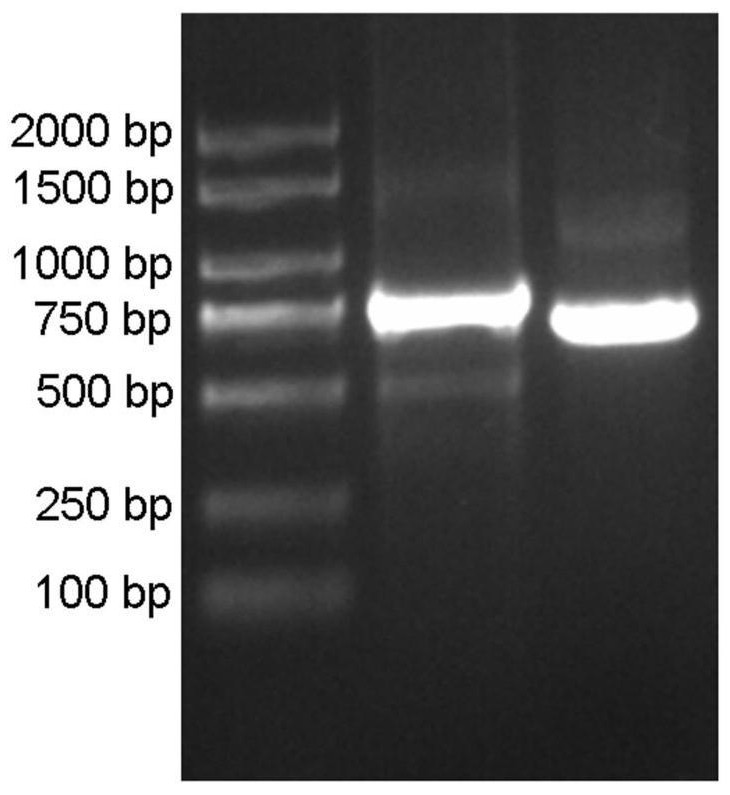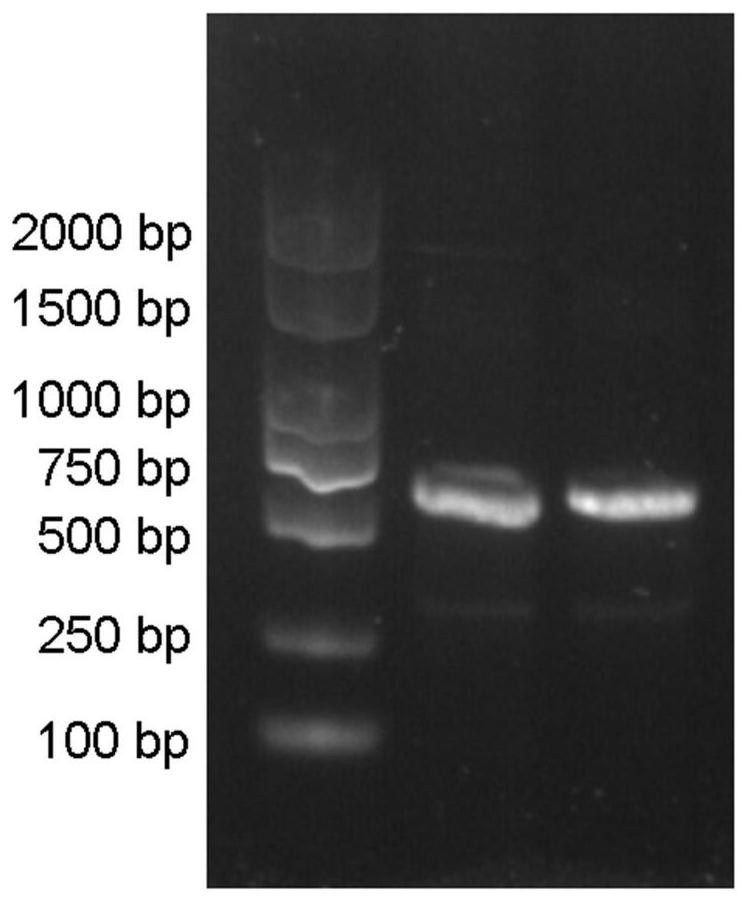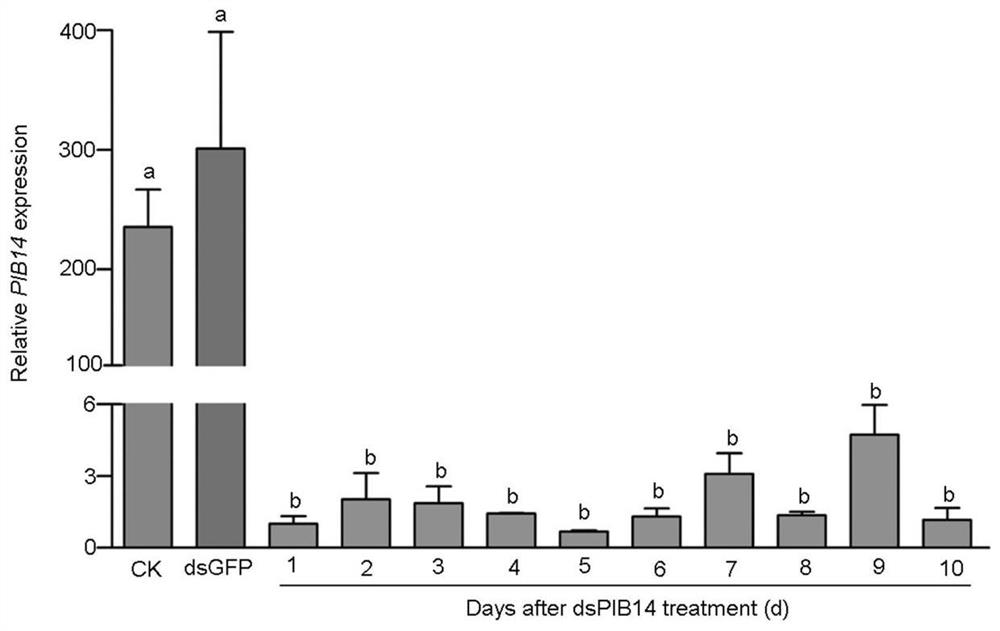Application of brown planthopper PIB14 protein and coding gene thereof to regulation and control of brown planthopper resistance of plants
A technology that encodes genes and resists brown planthoppers, applied in the field of genetic engineering, can solve problems such as harm to humans and animals, environmental pollution, etc., and achieve the effects of reducing the use of pesticides, good application prospects, maintaining ecological balance and sustainable development
- Summary
- Abstract
- Description
- Claims
- Application Information
AI Technical Summary
Problems solved by technology
Method used
Image
Examples
Embodiment 1
[0037] Cloning of Example 1 Brown Planthopper PIB14 Gene
[0038] Total RNA was extracted from 20 brown planthoppers of biotype 1 and reversed to cDNA. Primers were designed based on the sequence, and the 5' and 3' end sequences of the candidate gene were obtained using TaKaRa's 5' and 3' RACE kits, the transcription start site and termination site of the candidate gene were determined, and spliced out The full-length cDNA sequence of the gene. Re-synthesize primers PIB14-F and PIB14-R according to the full-length cDNA sequence, amplify the full-length cDNA of PIB14, and predict the ORF, and its ORF sequence is shown in the sequence table SEQ ID NO.1 ( figure 1 ).
[0039] PIB14-F: 5'-ACATGGGGCTCATTTTCTCCAAGCAT-3'
[0040] PIB14-R: 5'-GTATTTTATTTATTAAAAACACAAG-3'
Embodiment 2
[0041] Example 2 Preparation of the dsRNA (dsPIB14) for silencing the PIB14 gene of the brown planthopper and the green fluorescent protein GFP gene dsGFP for the control
[0042] 1. Using the cDNA obtained in Example 1 as a template, use PI-F and PI-R as primers to carry out PCR amplification to obtain a PCR amplification product.
[0043] PI-F (forward primer): 5'- TAATACGACTCACTATAGGGAGA CAGTCCTCCGAACAGGAATCGTACAG-3'
[0044] PI-R (reverse primer): 5'- TAATACGACTCACTATAGGGAGA TCCTCCACAGTTTCTCTCACACAGTTTCTC-3'.
[0045]The underlined region is the T7 RNA polymerase promoter sequence.
[0046] 2. Using the GFP-containing plasmid as a template and using dsGFP-F and dsGFP-R as primers to carry out PCR amplification to obtain PCR amplification products.
[0047] dsGFP-F (forward primer): 5'- TAATACGACTCACTATAGGG CGGACT-3'
[0048] dsGFP-R (reverse primer): 5'- TAATACGACTCACTATAGGG CGATGC-3'
[0049] The underlined region is the T7 RNA polymerase promoter sequence.
...
Embodiment 3
[0054] Example 3 Microinjection and effect detection of dsPIB14 and dsGFP
[0055] 1. Preparation of brown planthopper: Take 30 females and 10 males in a cup with TN1 seedlings. After 24 hours, take out the adults. After hatching, it will be a fourth instar nymph after 20 days, and it will be used for injection.
[0056] 2. Plate preparation: Weigh 1.5g of agar powder and add it to 100ml of water, boil it, pour it into a glass plate, and wait for it to solidify for later use.
[0057] 3. Injection: Take 5-8 worms with similar growth in the test tube, and inject CO 2 Anesthetized for 20s. The worms were then poured onto a 1.5% agar powder plate with the abdomen facing up. Injection was performed with Nanoliter2010 microinjector according to the instructions. The injection site is between the front and middle chest. The injection volume was 46 nl (5 μg / μL).
[0058] 4. After the brown planthopper was injected with dsRNA, samples were taken from the first day after the inje...
PUM
 Login to View More
Login to View More Abstract
Description
Claims
Application Information
 Login to View More
Login to View More - R&D
- Intellectual Property
- Life Sciences
- Materials
- Tech Scout
- Unparalleled Data Quality
- Higher Quality Content
- 60% Fewer Hallucinations
Browse by: Latest US Patents, China's latest patents, Technical Efficacy Thesaurus, Application Domain, Technology Topic, Popular Technical Reports.
© 2025 PatSnap. All rights reserved.Legal|Privacy policy|Modern Slavery Act Transparency Statement|Sitemap|About US| Contact US: help@patsnap.com



